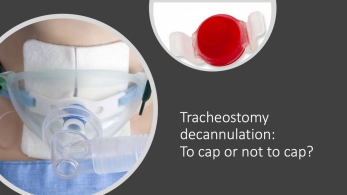Tracheostomy decannulation: To cap or not to cap?

A 49-year-old woman was intubated for acute hypoxemic respiratory failure secondary to pneumonia, which was complicated by empyema. She failed extubation and ultimately required tracheostomy for prolonged mechanical ventilation. After transfer to the intermediate care unit, she was successfully weaned from the ventilator for over 24 hours. She tolerated prolonged deflation of her tracheostomy cuff and swallowed water without aspiration. She underwent a tracheostomy tube occlusion test and there was no obstruction to air flow with a size 7 fenestrated tracheostomy tube in place. She is requiring suctioning once every 12 hours. You are assessing her readiness for tracheostomy decannulation and are considering the utility of a capping trial.

